Jenin still screams
My friend Marwan mentioned Jenin (Ja-neen) when I asked about more places to observe the continuing Israeli occupation of Palestine.
And it all came flooding back, memories of the 2002 Israeli military incursion into the narrow populated streets of Jenin punctuated by close-in fighting decided only by the invaders reliance on heavy weapons, Merkava tanks, helicopter gun ships, and weaponized bulldozers.
Jenin was real deal Middle East urban warfare where outgunned Palestinian fighters had forever stood up and delivered themselves into revolutionary battle lore, no matter the outcome, alongside the defenders of Soviet Stalingrad, Jewish Warsaw, the Paris Commune, and Republican Madrid.
I had to see Jenin.
But it wasn’t close to Jerusalem, and required I take buses to Ramallah, maybe Nablus, and finally Jenin in the far northern occupied West Bank. Things are moving fast here. I just read where the US Donald Trump regime has now unjustifiably deleted the term “occupied territories” in reference to Palestinian lands in its latest human rights report.
Israeli Prime Minister Benjamin Netanyahu has at last found his perfect American patsy. Going against international law and American tradition, the US recognition of Jerusalem as the Israeli capital by moving the official American Embassy to this divided ancient city on May 14 is now only days away.
The early morning bus near the Damascus Gate to Ramallah was quick enough, but I had to wait more than an hour there for the filthy beat-up shuttle in a dirty open-air terminal to fill up with passengers to Jenin. The price of 19 shekels from Ramallah to Jenin was very cheap, the same cost as a double espresso in the cafe at my Austrian Hospice residence in East Jerusalem’s Old Muslim Quarter. We traveled the hilly rocky countryside under clear weather, though rain was forecast.
Hustle & bustle in downtown Jenin
Damn, Jenin was a happening place. The bustle and hustle and traffic and shops were overflowing in the city center of this town of nearly 40,000 when I stepped off my shuttle at midday. I simply walked the main streets for a bit taking it all in while searching for a wifi cafe to hunker down and get my bearings. Where exactly did the battle take place?
I spoke with a senior Palestinian man selling beautiful sweets on huge round metal trays out of the back of his car. “Where are you from? America! I was born in Haifa in 1948. I’m 71 and healthy,” he proudly told me, and offered me a gorgeously thick rich layered pastry topped with chopped nuts and refused any kind of payment. I sat on an overturned 5-gallon bucket, and we small talked while I finished off my edible treasure.
Within a few minutes I was directed to a second-story cafe with a narrow balcony overlooking the electric street below. All the balcony spots were apparently taken, but I settled into an unoccupied seat at a small table where this young adult sat confidently pulling light pleasing smoke from a tall bubbling hooka.
”Do you mind?”
“No, please sit down.”
Tareq Jarrar, 28, said he was a captain in the Palestinian Authority’s presidential guard unit, and often traveled abroad as liaison to foreign interior ministries. Jarrar said he provides security to President Mahmoud Abbas, and was in the PA detail that guarded President Trump during his visit to Bethlehem in May 2017. The unassuming pleasant guy is married with a small child who lives in a neighboring village.
“Just talk,” Jarrar responded when I asked what people in America could do to help bring about real peace in the Palestinian-Israeli conflict. He took another pull on his pipe emitting the curling languid white cloud streams that caused me no annoyance or bother.
The Israeli military had been nowhere in sight on the road here and so far no presence inside this section of Jenin. “They only come sometimes very late at night with no one around. Drive around the city center. Not regular. Not even every week.”
“Mukhayam! Mukhayam!”
“So what about the Battle of Jenin. Where did it happen?”
“Mukhayam! Mukhayam!”
“What does that mean? The district name?’
“Mukhayam Jenin!”
We fumbled with translation aps on our phones until I understood the Arabic word for refugee camp. Of course. The worst shit always goes down in the refugee camps, absolutely the poorest and most hopeless population centers. Absolutely hell on earth. And folks wonder why I’m an atheist.
The camp was apparently only a 20 minute walk right down the street, according to Jarrar and Google maps. Nice to see that feature was working for the moment. Sometimes yes, most often and disappointingly no during my current Middle East venture.
As I walked down the main boulevard past the last city center modern shops and business fronts, past the hospital facilities that had once been a frontline battle outpost besieged by Israeli forces, I was right there walking down the grimy beat up commercial edge of the Mukhayam Jenin. It was not a camp in the sense that some people might visualize a sprawling tent city on an open hardscrabble plain or desert wasteland.
No, this was a Middle East poverty-ridden garbage strewn enclave of broken streets and low-level buildings on rising hills with endless narrow twisting byways dotted everywhere with political posters of AK 47-toting young men superimposed next to the golden dome Al-Aqsa Mosque. Overhead wires on some street corners flew plastic green, red, black and white Palestinian flags next to unmistakable yellow Fatah banners. Something serious had gone down right here.
Give me money!
All of a sudden there were a dozen young boys around me, some with hands out. “Where you from? What’s your name? Give me money!” I get that a lot in Palestine. At the Damascus Gate. Inside the Old City. And now in the Mukhayam Jenin. But the kids here weren’t overly aggressive, and I kept talking and walking around.
One older boy on a bicycle named Eyad understood what I wanted and took me around a corner and pointed up at the two-story building wall fronting us. It was riddled with wild machine gun bullet sprays in the hardened concrete around a window on the street facing wall of the nondescript residence.
Palestinians in Mukhayam Jenin had reportedly been relocated into this district after being forced from their homes in the Haiffa region and elsewhere by armed Zionist units in the aftermath of the fighting at the creation of Israel in 1948. According to the wiki page, the 2002 Battle of Jenin took place in this refugee camp approximately April 1–11 that year. Israel Defense Forces (IDF) entered the camp, and other areas under the administration of the Palestinian Authority, during the Second Intifada, as part of what Tel Aviv labelled Operation Defensive Shield.
As I was standing there in the middle of the broken road with the kids, a guy in his late 20’s, early 30’s walked over and asked “What do you want?” He had the worn out pained appearance of an addict who was up too soon and very pissed off. Still, I was thankful to have an adult around and was able to get across my motives for being there, I think.
“Where is the place that was flattened and leveled by the tanks and bulldozers? Someone told me they have rebuilt.”
We struggled to understand each other, and he pointed up the rising street.”
“I must go.”
I thanked him, and started up that way. Israeli tanks had repeatedly shelled the camp, and weaponized Caterpillar bulldozers were brought in to widen the narrow streets, set off booby trap mines, and flatten buildings. Claims of war crimes against Israel were made by individuals and groups who said Palestinian civilians were buried alive in the bulldozed rubble. Claims of an outright massacre in Jenin by Israel linger to this day. According to the wiki page, at the time, senior Palestinian official Saeb Erekat suggested to CNN that some 500 Palestinians had been killed in the camp. Five days later, when the fighting stopped, PA Secretary Ahmed Abdel Rahman told UPI news that the number was in the thousands, hinting, along with other Palestinian figures, that Israel had snatched bodies, buried Palestinians in mass graves and under the rubble of ruined buildings, and otherwise conducted activities on a scale compatible with genocide.
Stories of hundreds of civilians killed in their homes as they were demolished spread throughout international media, according to the wiki page, adding that subsequent investigations found no evidence to substantiate claims of a massacre, and official totals from Palestinian and Israeli sources confirmed between 52 and 54 Palestinians, mostly gunmen, and 23 IDF soldiers as killed in the fighting. Israel said that the Jenin camp was the home of many suicide bombers, and other attack stagings on its population prior to its April invasion of the camp of more than 13,000 residents.
We didn’t think . . . be so hard.
General Dan Harel, head of the IDF Operations Directorate, reportedly said “There were indications it was going to be hard, but we didn’t think it was going to be so hard.”
Yasser Arafat visited the Mukhayam and declared it Jenin-grad recalling the infamous Nazi siege on Stalingrad.
A lot has happened between the Battle of Jenin and now, including 40 Palestinian protesters killed and 5,511 wounded by the Israeli military in the mass mostly nonviolent March of Return protests along the border fence between the Gaza Strip and Israel since March 30 this year, the United Nations Office for the Coordination of Humanitarian Affairs reported a few days ago, according to the Israeli newspaper Haaretz. At least 450 of the wounded are minors.
So you will just have to excuse the folks who have a problem still believing only about 50 Palestinians, mostly gunmen, were killed in Jenin during an all-out urban warfare scenario. Please.
I found a little convenience shop at a convergence of two unnamed streets in the camp and bought a cold soda. The kids still hung around, and an old man tried to unsuccessfully shoo them away. No one else was walking around under the threatening skies, but a car or two rumbled through. I walked off around the corner, and a middle-aged man was tending to something on his front stoop. He looked dirty and disheveled, and told me there were no jobs in the camp. After I explained my presence there, he pointed out shrapnel blast marks on the building across the street caused by Israeli shells.
“Are there any fighters here I could talk to?”
“They don’t know any English. I don’t know.”
The boys had finally all ignored me and wandered off by then. So I started back down the narrow hillside streets past graffiti-laced buildings and no pedestrians. I finally saw a grizzled old man sitting by a doorway as I left the winding streets behind. He pointed to his folded leg, which was in some distress. I don’t think he could walk.
A couple young boys quickly walked up and interrogated me again. Things were quite pleasant for the moment, but the dark clouds continued to roll in and a few sprinkles began to fall. I really hated the hot sunny climes, so the recent chilly weather and any chance for actual rain were very welcome developments.
Welcome, welcome!
I could hear a woman in the inside of the home saying “Welcome, welcome!” when a decent Chevrolet sedan drove up and out popped the 30something man of the house with his hands full of plastic bags of food.
“Welcome. Come inside,” he genuinely offered, but I had to beg off not being sure of the time when the bus back to Ramallah might leave. I heard that they started on the road earlier than I was expecting.
“Please have hummus!” the man directed toward me as he lifted a handful of chickpea pods from one bag.
“Just a few please. Really,” I responded and fumbled to tear open the pod casings to retrieve my two edible chickpeas inside each one. I stashed the rest in my pocket for later and walked down the street back to the modern hustling heart of commercial Jenin only a few meters away.
The light rain quickly became a torrential dirt-road and low-lying home washout flood.[]
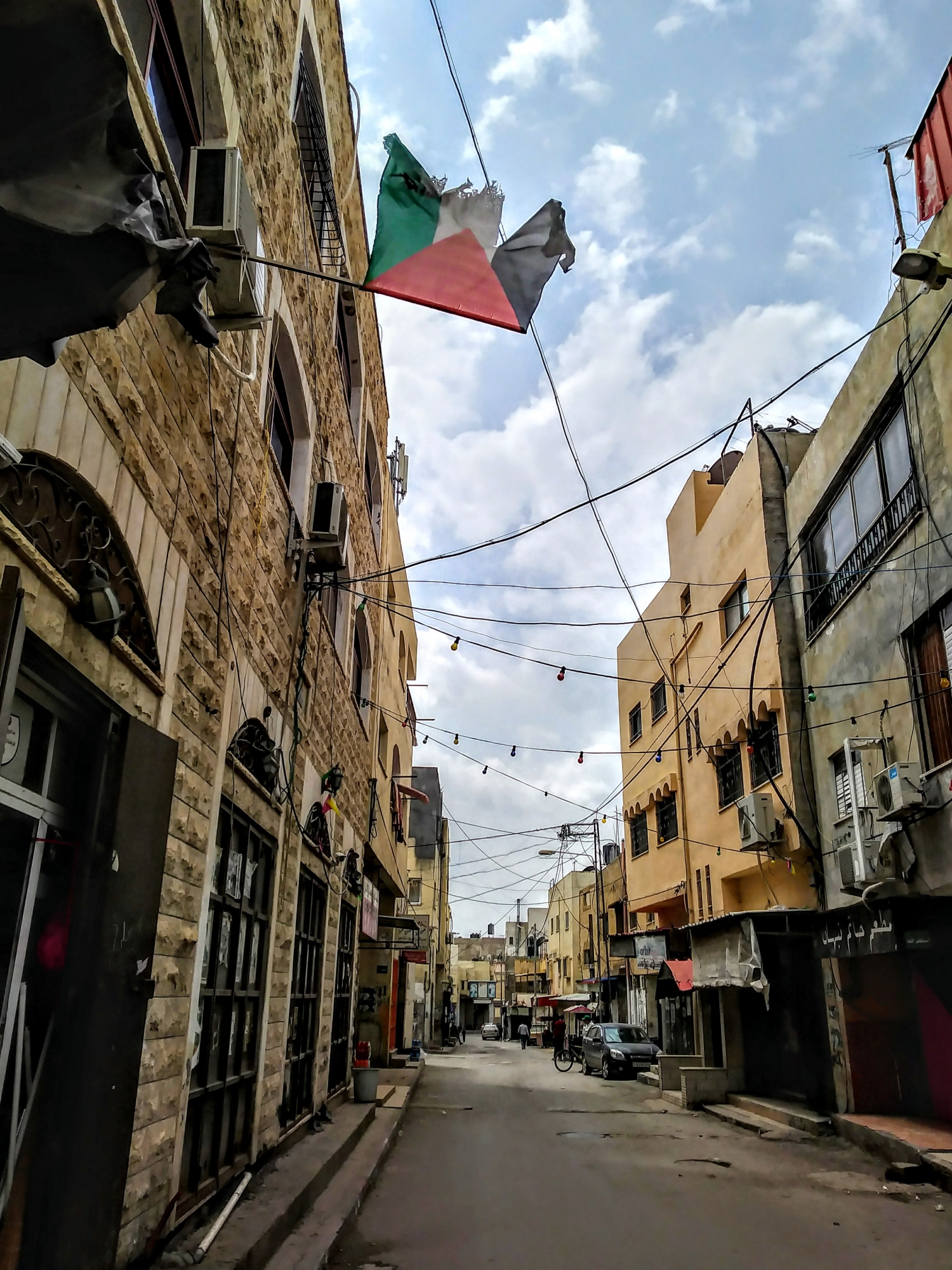 Still standing. Grimy business street fronting the Jenin refugee camp, site of a bloody two-week siege between Palestinian fighters & the Israeli military in April 2002.
Still standing. Grimy business street fronting the Jenin refugee camp, site of a bloody two-week siege between Palestinian fighters & the Israeli military in April 2002.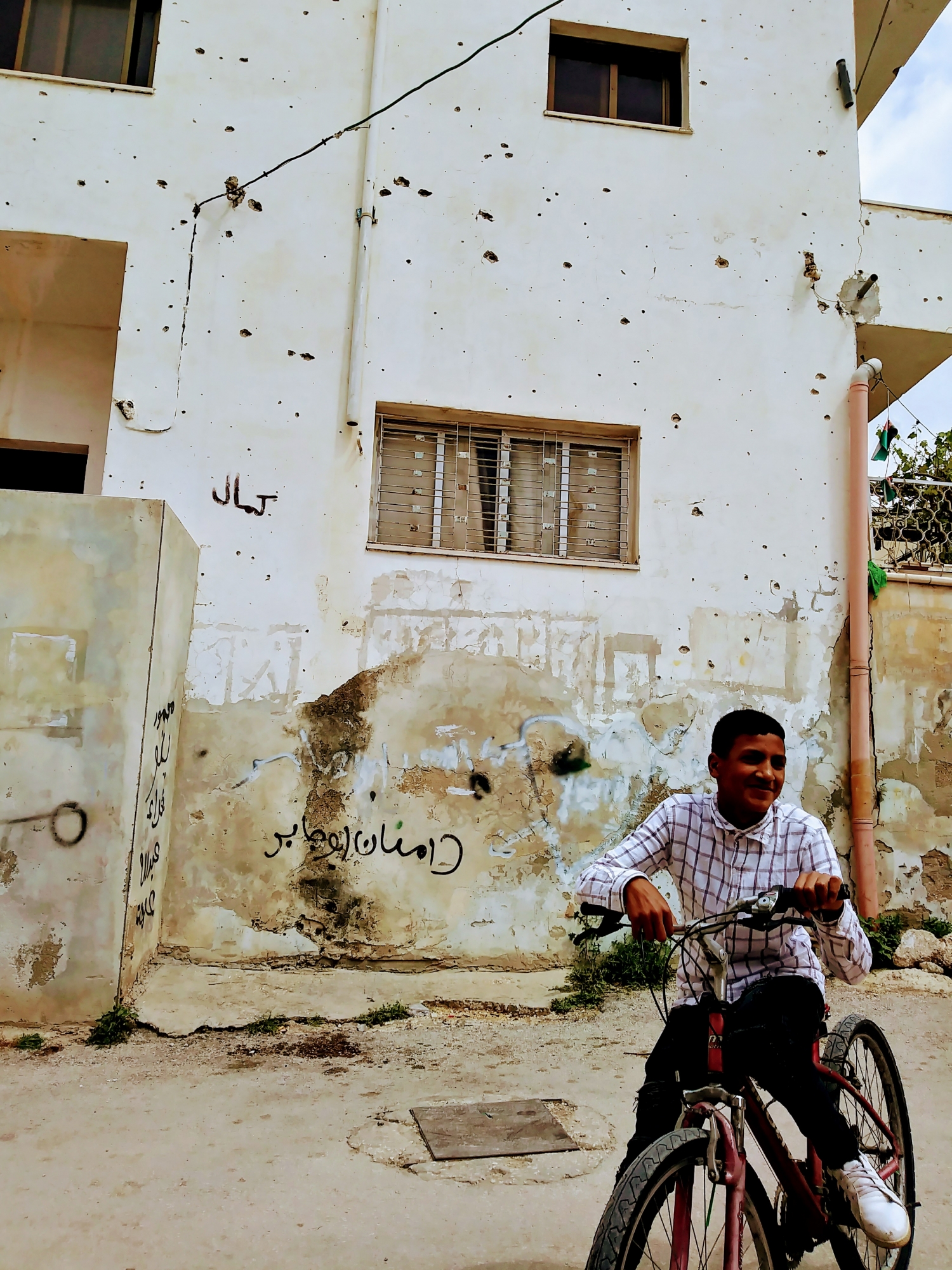 Wild machine gun spray damage from battle nearly 20 years ago.
Wild machine gun spray damage from battle nearly 20 years ago.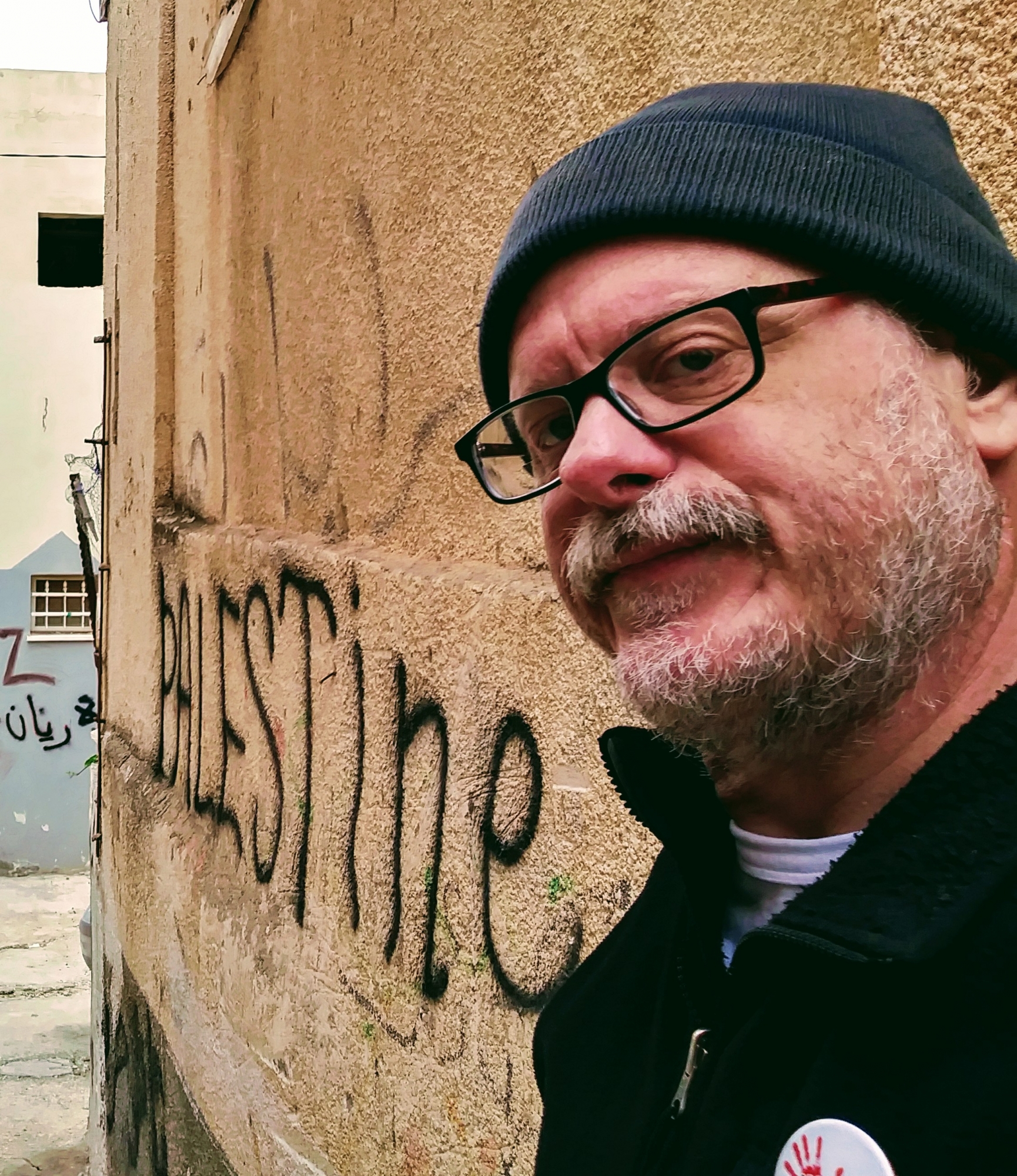 In the winding narrow streets of Mukhayam Jenin.
In the winding narrow streets of Mukhayam Jenin.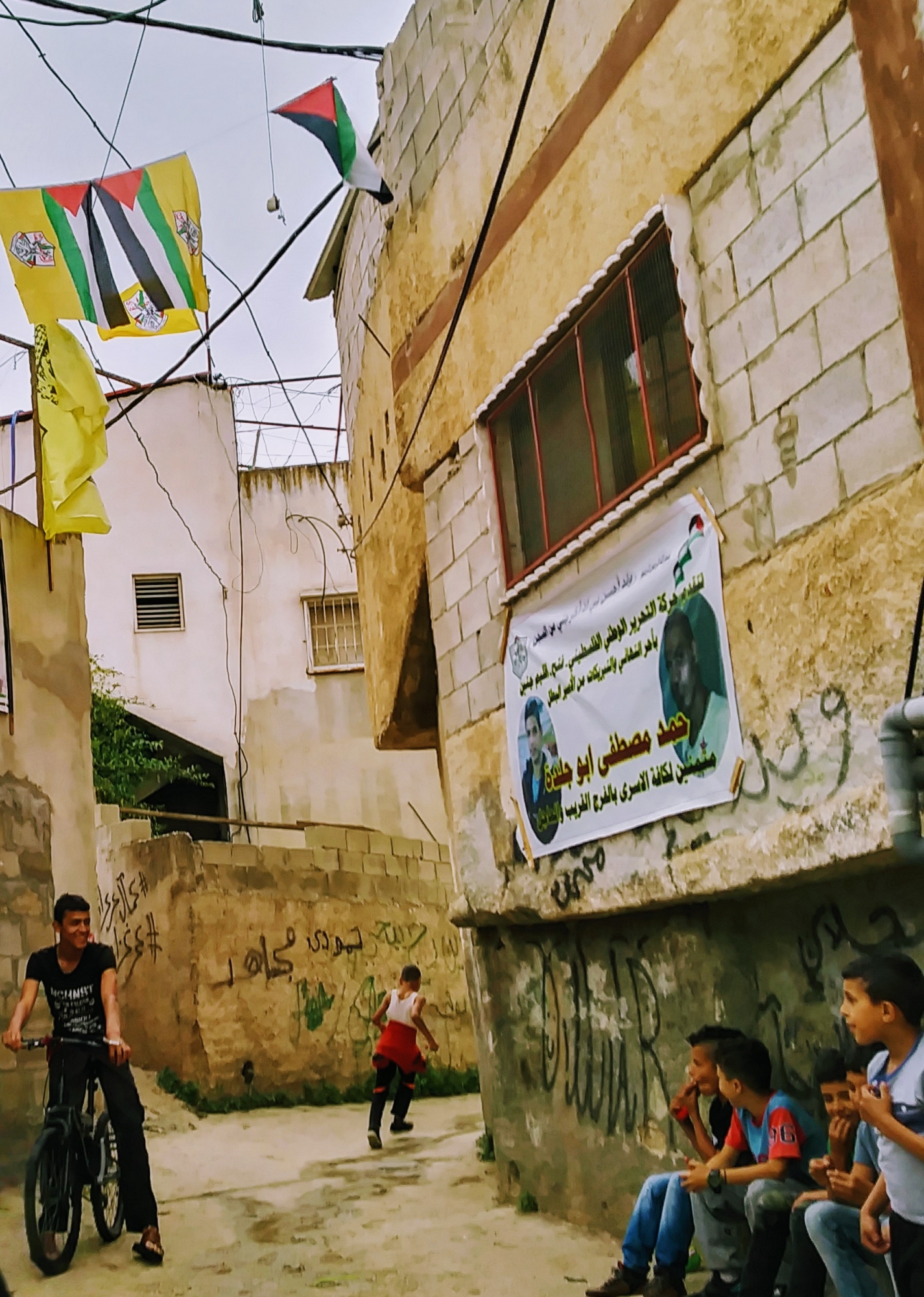 Tattered banners of Palestine and the Fatah Movement inside the Mukhayam Jenin. Young boys roam the midday streets.
Tattered banners of Palestine and the Fatah Movement inside the Mukhayam Jenin. Young boys roam the midday streets. 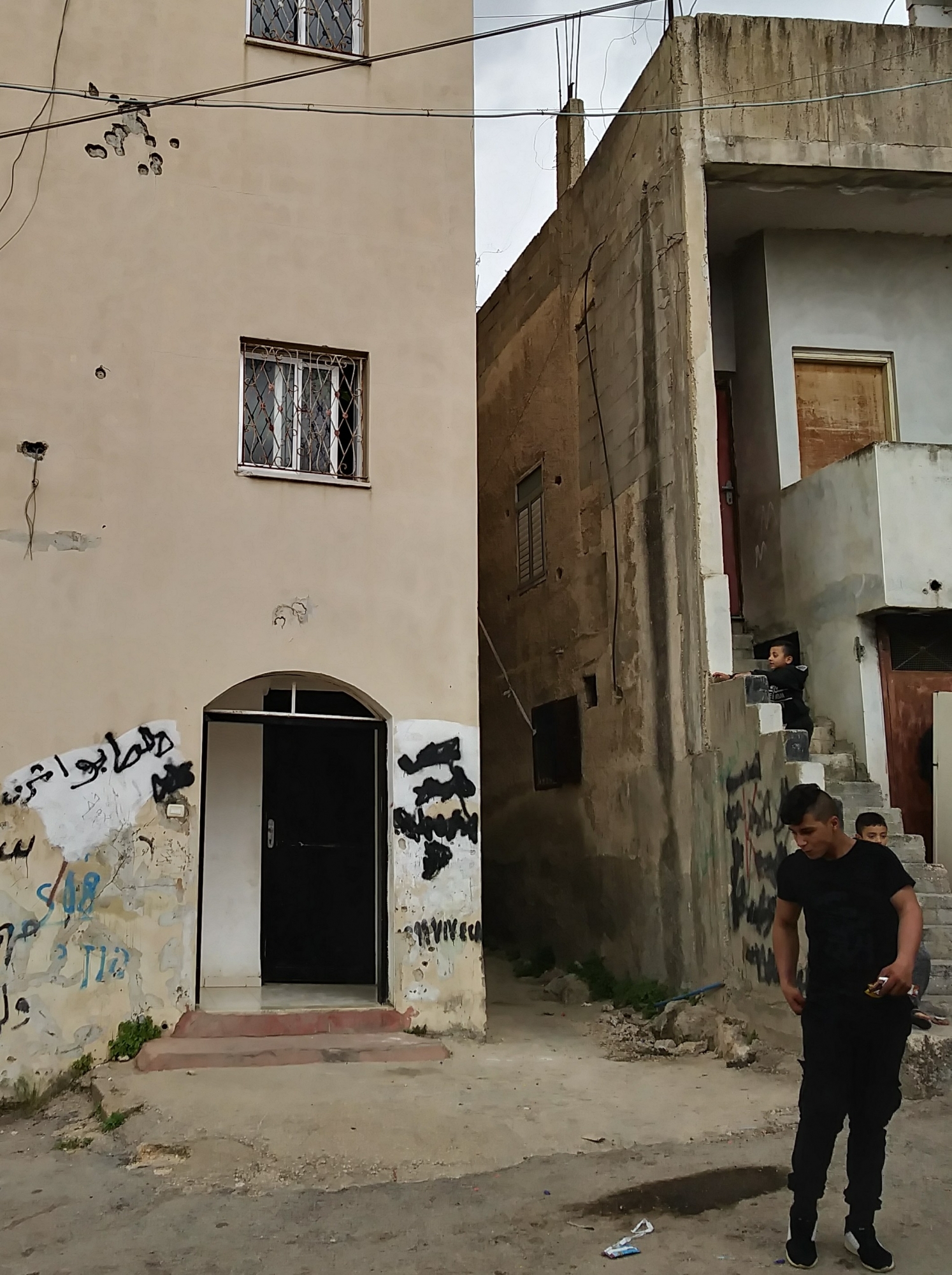 Resident pointed out what he said are shrapnel bursts up high on Jenin refugee camp buildings from the 2002 conflict.
Resident pointed out what he said are shrapnel bursts up high on Jenin refugee camp buildings from the 2002 conflict.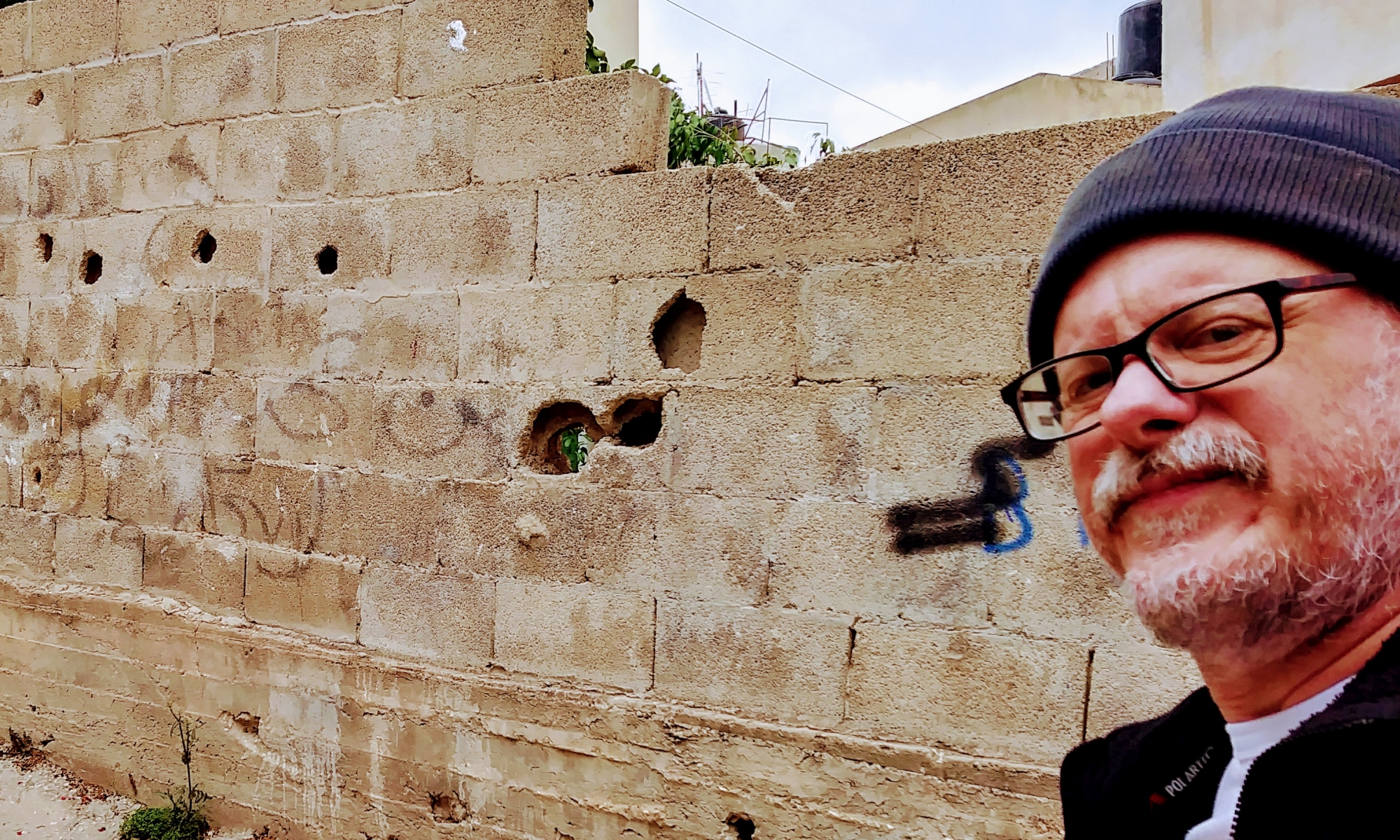 Damage still evident from the Battle of Jenin.
Damage still evident from the Battle of Jenin.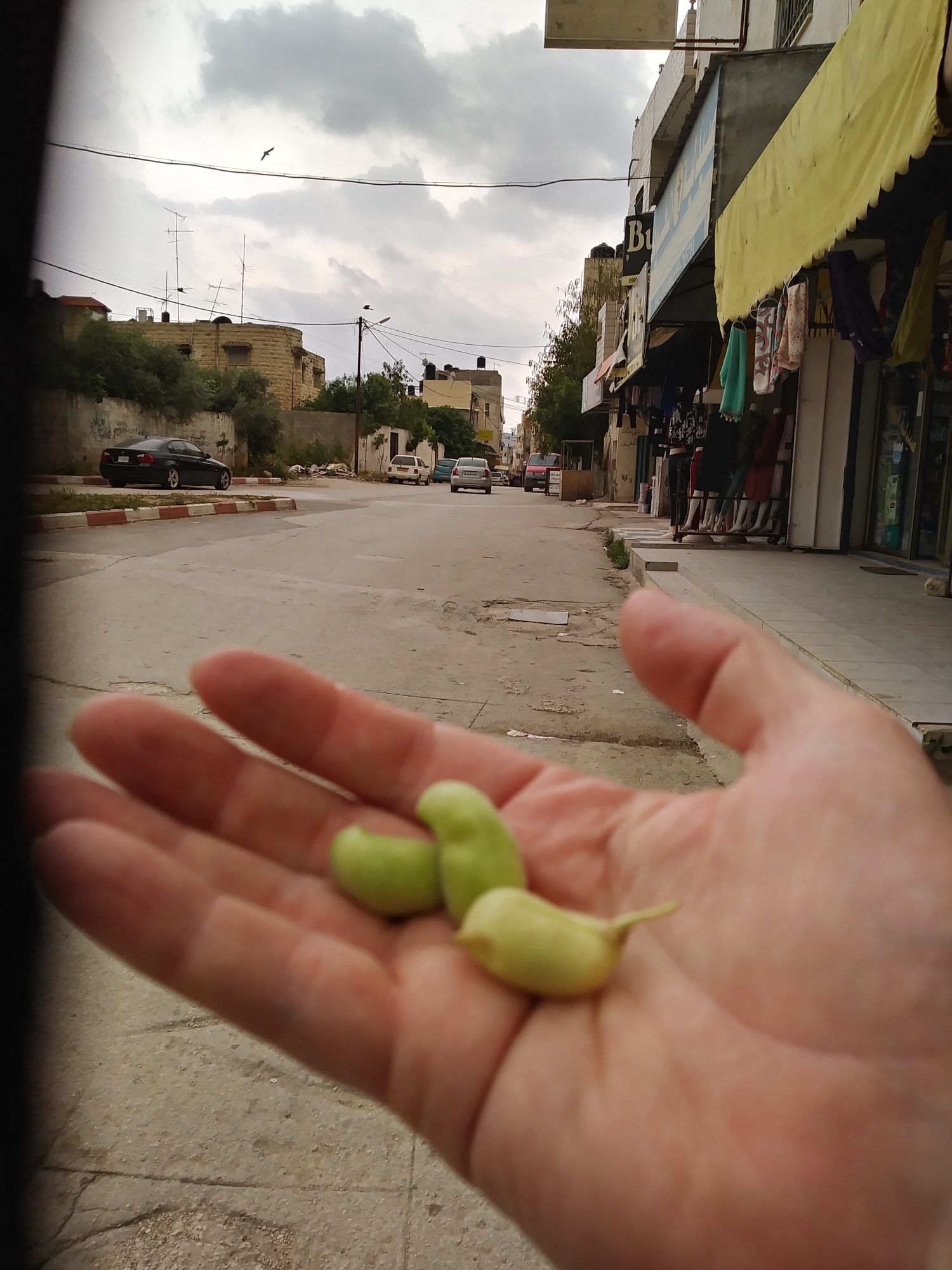 With storm clouds rolling in, kind offering of chickpeas snacks generally used for hummus from residents of the Mukhayam Jenin. (L. Maushard photos)
With storm clouds rolling in, kind offering of chickpeas snacks generally used for hummus from residents of the Mukhayam Jenin. (L. Maushard photos)

